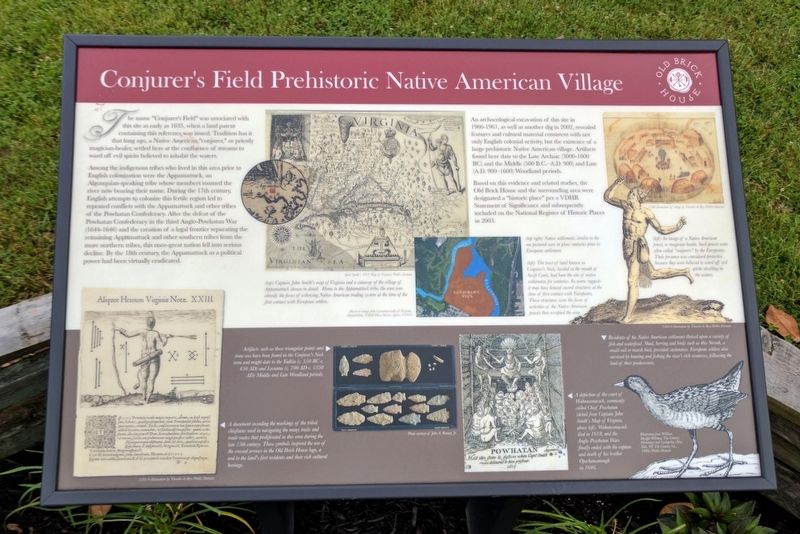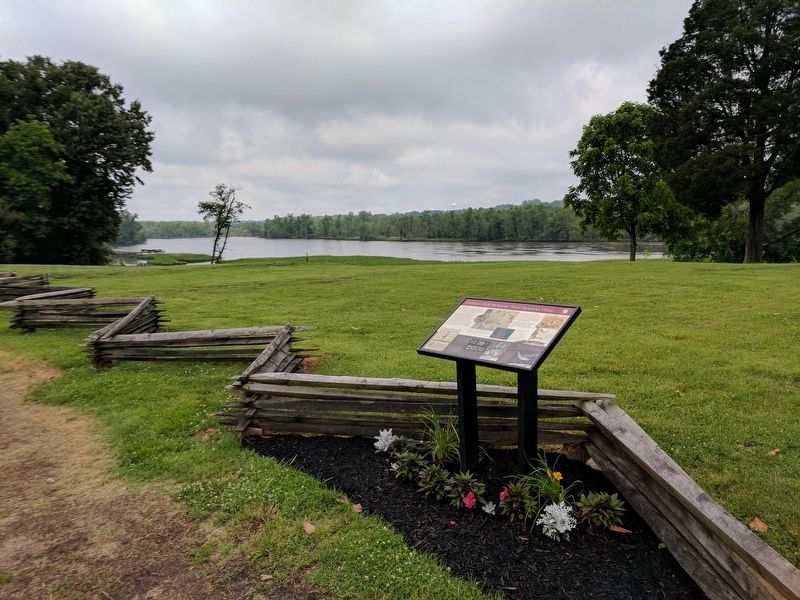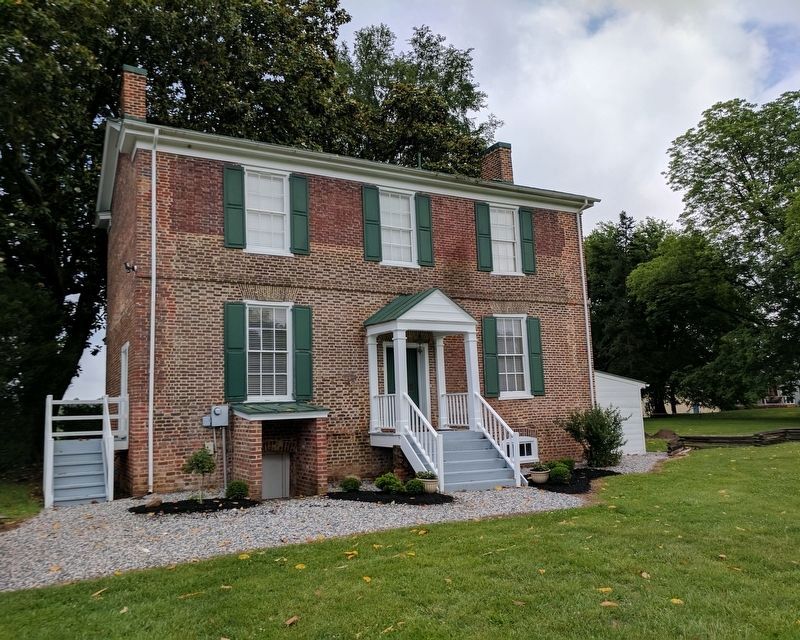Colonial Heights, Virginia — The American South (Mid-Atlantic)
Conjurer's Field Prehistoric Native American Village
Inscription.
The name “Conjurer's Field” was associated with this site as early as 1635, when a land patent containing this reference was issued. Tradition has it that long ago, a Native American "conjurer,’ or priestly magician-healer, settled here at the confluence of streams to ward off evil spirits believed to inhabit the waters.
Among the indigenous tribes who lived in this area prior to English colonization were the Appamattuck, an Algonquian-speaking tribe whose members roamed the river now bearing their name. During the 17th century, English attempts to colonize this fertile region led to repeated conflicts with the Appamattuck and other tribes of the Powhatan Confederacy. After the defeat of the Powhatan Confederacy in the third Anglo-Powhatan War (1644-1646) and the creation of a legal frontier separating the remaining Appamattuck and other southern tribes from the more northern tribes, this once-great nation fell into serious decline. By the 18th century, the Appamattuck as a political power had been virtually eradicated.
An archaeological excavation of this site in 1966-1967, as well as another dig in 2002, revealed features and cultural material consistent with not only English colonial activity, but the existence of a large prehistoric Native American village. Artifacts found here date to the Late Archaic (3000-1000 BC) and the Middle (500 B.C.—A.D. 900) and Late (A.D. 900—1600) Woodland periods.
Based on this evidence and related studies, the Old Brick House and the surrounding area were designated a "historic place" per a VDHR Statement of Significance and subsequently included on the National Register of Historic Places in 2003.
(captions)
(top) Captain John Smith’s map of Virginia and a cutaway of the village of Appamattuck shown in detail. Home to the Appamattuck tribe, the area was already the focus of a thriving Native American trading system at the time of the first contact with European settlers.
(top right) Native settlements similar to the one pictured were in place centuries prior to European settlement. 1590 illustration of village by Theodor de Bry/Public Domain
(left) The tract of land known as in Conjurer's Neck, located at the mouth of Swift Creek, had been the site of native settlement for centuries. Its name suggests it may have housed sacred structures at the time of first contact with Europeans. These structures were the focus of activities of the Native American priests that occupied them. Based on image from Commonwealth of Virginia, DigitalGlobe, USDA Farm Servie Agency ©2016
(left) An image of a Native American priest, or magician-healer. Such priests often called "conjurers" by the Europeans. Their presence was considered protective because they were believed to ward off evil spirits dwelling in the waters. 1585-6 illustration by Theodor de Bry/Public Domain
A document recording the markings of the tribal chieftains used in navigating the many trails and trade routes that proliferated in this area during the late 15th century. These symbols inspired the use of the crossed arrows in the Old Brick House logo, a nod to the land’s first residents and thei rich cultural heritage. 1585-6 illustration by Theodor de Bry/Public Domain
Artifacts such as these triangular points and stone axe have been found in the Conjurer’s Nech area and might date to the Yadkin (c. 350 BC-c. 450 AD) and Levanna (c. 700 AD-c. 1350 AD) Middle and Late Woodland periods. Photo courtesy of John A. Rooney. Jr.
A depiction of the court of Wahunsonacock, commonly called Chief Powhatan (detail from Captain John Smith’s Map of Virginia, above left). Wahunsonacock died in 1618, and the Anglo-Powhatan Wars finally ended with the capture and death of his brother Opechancanough in 1646.
Residents of the Native American settlement thrived upon a variety of fish and waterfowl. Shad, herring and birds such as this Sorrah, a small rail or marsh bird, provided sustenance. European settlers also survived by hunting and fishing the river’s rich resources, following the lead of their predecessors. Illustration from William Dwight Whitney, The Century Dictionary and Cyclopedia (New York, NY; The Century Co., 1889)/Public Domain
Erected by The Old Brick House Foundation.
Topics. This historical marker is listed in these topic lists: Anthropology & Archaeology • Colonial Era • Native Americans • Settlements & Settlers. A significant historical year for this entry is 1635.
Location. 37° 17.131′ N, 77° 21.955′ W. Marker is in Colonial Heights, Virginia. Marker is on Waterfront Drive east of Dunston Point Parkway, on the right when traveling east. Touch for map. Marker is at or near this postal address: 131 Waterfront Dr, Colonial Heights VA 23834, United States of America. Touch for directions.
Other nearby markers. At least 8 other markers are within 3 miles of this marker, measured as the crow flies. The Old Brick (Kennon) House (here, next to this marker); The Brick House At Conjurer's Neck (within shouting distance of this marker); Fort Clifton (approx. ¼ mile away); a different marker also named Fort Clifton (approx. 0.3 miles away); a different marker also named Fort Clifton (approx. half a mile away); Confederate Fortification (approx. 0.6 miles away); Ellerslie (approx. 2.3 miles away); a different marker also named Ellerslie (approx. 2.3 miles away). Touch for a list and map of all markers in Colonial Heights.
Also see . . . The Old Brick House Foundation. (Submitted on May 29, 2017.)
Credits. This page was last revised on April 30, 2021. It was originally submitted on May 29, 2017, by Bernard Fisher of Richmond, Virginia. This page has been viewed 567 times since then and 42 times this year. Photos: 1, 2, 3. submitted on May 29, 2017, by Bernard Fisher of Richmond, Virginia.


